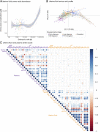Amino acids activate mTORC1 to release roe deer embryos from decelerated proliferation during diapause
- PMID: 34452997
- PMCID: PMC8536382
- DOI: 10.1073/pnas.2100500118
Amino acids activate mTORC1 to release roe deer embryos from decelerated proliferation during diapause
Abstract
Embryonic diapause in mammals leads to a reversible developmental arrest. While completely halted in many species, European roe deer (Capreolus capreolus) embryos display a continuous deceleration of proliferation. During a 4-mo period, the cell doubling time is 2 to 3 wk. During this period, the preimplantation blastocyst reaches a diameter of 4 mm, after which it resumes a fast developmental pace to subsequently implant. The mechanisms regulating this notable deceleration and reacceleration upon developmental resumption are unclear. We propose that amino acids of maternal origin drive the embryonic developmental pace. A pronounced change in the abundance of uterine fluid mTORC1-activating amino acids coincided with an increase in embryonic mTORC1 activity prior to the resumption of development. Concurrently, genes related to the glycolytic and phosphate pentose pathway, the TCA cycle, and one carbon metabolism were up-regulated. Furthermore, the uterine luminal epithelial transcriptome indicated increased estradiol-17β signaling, which likely regulates the endometrial secretions adapting to the embryonic needs. While mTORC1 was predicted to be inactive during diapause, the residual embryonic mTORC2 activity may indicate its involvement in maintaining the low yet continuous proliferation rate during diapause. Collectively, we emphasize the role of nutrient signaling in preimplantation embryo development. We propose selective mTORC1 inhibition via uterine catecholestrogens and let-7 as a mechanism regulating slow stem cell cycle progression.
Keywords: European roe deer (Capreolus capreolus); embryo development; embryonic diapause.
Copyright © 2021 the Author(s). Published by PNAS.
Conflict of interest statement
The authors declare no competing interest.
Figures






Similar articles
-
Uterine fluid proteome changes during diapause and resumption of embryo development in roe deer (Capreolus capreolus).Reproduction. 2019 Jul;158(1):13-24. doi: 10.1530/REP-19-0022. Reproduction. 2019. PMID: 30933930 Free PMC article.
-
Embryonic diapause in roe deer: A model to unravel embryo-maternal communication during pre-implantation development in wildlife and livestock species.Theriogenology. 2020 Dec;158:105-111. doi: 10.1016/j.theriogenology.2020.06.042. Epub 2020 Jul 6. Theriogenology. 2020. PMID: 32947063 Review.
-
Review: Embryonic diapause in the European roe deer - slowed, but not stopped.Animal. 2023 May;17 Suppl 1:100829. doi: 10.1016/j.animal.2023.100829. Animal. 2023. PMID: 37567662 Review.
-
Roe deer uterine fluid metabolome reveals elevated glycolysis, fatty acid breakdown, and spermidine synthesis upon reactivation from diapause†.Biol Reprod. 2025 Jan 14;112(1):70-85. doi: 10.1093/biolre/ioae161. Biol Reprod. 2025. PMID: 39673258 Free PMC article.
-
Description of post-implantation embryonic stages in European roe deer (Capreolus capreolus) after embryonic diapause.Anat Histol Embryol. 2017 Dec;46(6):582-591. doi: 10.1111/ahe.12315. Epub 2017 Sep 27. Anat Histol Embryol. 2017. PMID: 28960412
Cited by
-
Efficient cell chatting between embryo and uterus ensures embryo implantation†.Biol Reprod. 2022 Jul 25;107(1):339-348. doi: 10.1093/biolre/ioac135. Biol Reprod. 2022. PMID: 35774025 Free PMC article.
-
Beyond energy and growth: the role of metabolism in developmental signaling, cell behavior and diapause.Development. 2023 Oct 15;150(20):dev201610. doi: 10.1242/dev.201610. Epub 2023 Oct 26. Development. 2023. PMID: 37883062 Free PMC article.
-
Matching the green wave: growing season length determines embryonic diapause in roe deer.Proc Biol Sci. 2025 May;292(2047):20242903. doi: 10.1098/rspb.2024.2903. Epub 2025 May 21. Proc Biol Sci. 2025. PMID: 40393484 Free PMC article.
-
mTOR activity paces human blastocyst stage developmental progression.Cell. 2024 Nov 14;187(23):6566-6583.e22. doi: 10.1016/j.cell.2024.08.048. Epub 2024 Sep 26. Cell. 2024. PMID: 39332412 Free PMC article.
-
Molecular Regulators of Embryonic Diapause and Cancer Diapause-like State.Cells. 2022 Sep 20;11(19):2929. doi: 10.3390/cells11192929. Cells. 2022. PMID: 36230891 Free PMC article. Review.
References
-
- Renfree M. B., Fenelon J. C., The enigma of embryonic diapause. Development 144, 3199–3210 (2017). - PubMed
-
- Bischoff T. L. W., Die Entwicklungsgeschichte des Rehes (J. Bicker'sche Buchhandlung, Giessen, 1854).
-
- Aitken R. J., Delayed implantation in roe deer (Capreolus capreolus). J. Reprod. Fertil. 39, 225–233 (1974). - PubMed
-
- van der Weijden V. A., Ulbrich S. E., Embryonic diapause in roe deer: A model to unravel embryo-maternal communication during pre-implantation development in wildlife and livestock species. Theriogenology 158, 105–111 (2020). - PubMed
-
- van der Weijden V. A., Ulbrich S. E., Embryonic diapause in the European roe deer (Capreolus capreolus). Bioscientifica Proc. 10, 582–591 (2020).
Publication types
MeSH terms
Substances
LinkOut - more resources
Full Text Sources
Molecular Biology Databases

